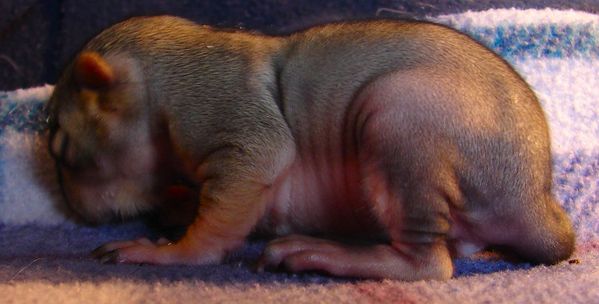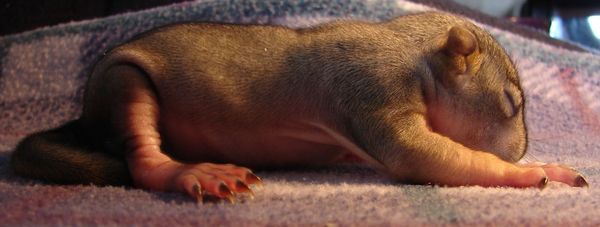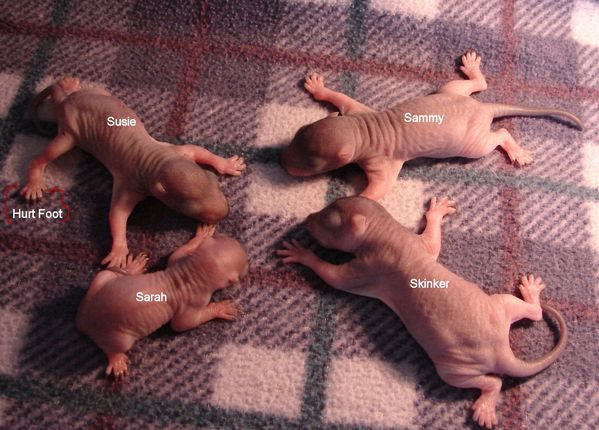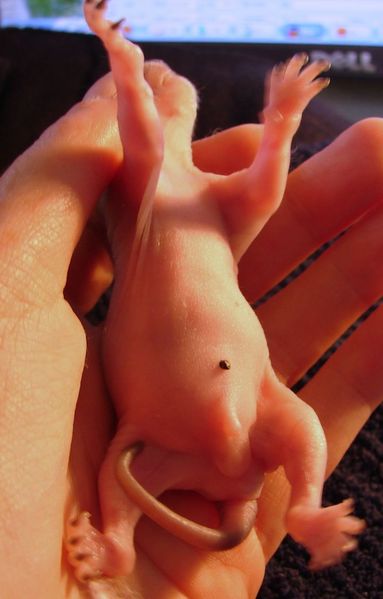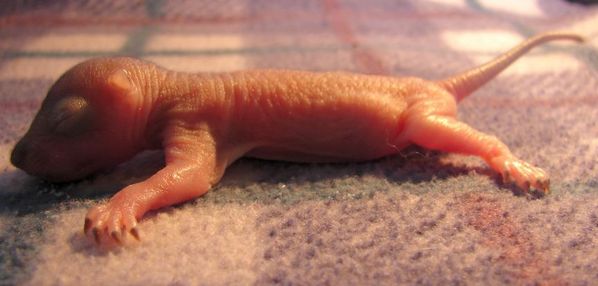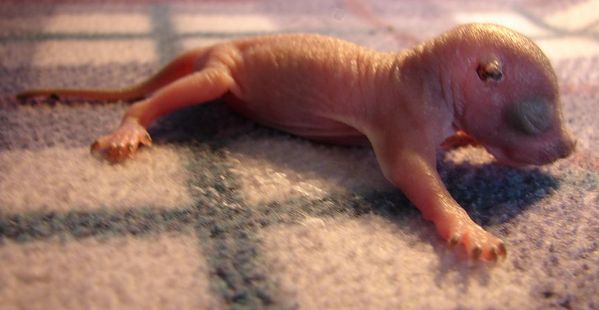Feb 27, 2007
Cat Food and Nutrition
Food Choices - Adoption - and Compromises
While in a perfect world people would feed their cats the best possible foods, there are times when this is impossible, for a variety of reasons. Would a cat in a kill shelter be better off left there because a potential adopter couldn't afford the best foods? Look here for a discussion of compromises in cat food choices that might be necessary at times.
Quick Tip - Making Water More Interesting to Cats
Here's a quick tip for stimulating your cat's interest in drinking water during hot summer months.
The Role of Food in Your Cat's Health
Outside of regularly veterinary care, the food your cat eats is the most important factor to his health and longevity. These lessons will teach you everything you need to know about cat food: how to read labels, how to choose it, and foods you should avoid, and why.
Tips for Choosing Cat Food - Learning the Basics about Cat Food Labels
The ultimate purpose of this series is to help you learn how to read cat food labels to make your decision process easier in choosing the best foods for your cat
Understanding Cat Food Labels - the formulas you need
Learn how to analyze cat food labels to better understand the meaning of the "Guaranteed Analysis" section, and exactly what the AAFCO can and cannot do in regulating cat food.
Natural Raw Food Diet for Cats - The Hows and Whys of Feeding Cats Raw
A carefully home-prepared raw food diet closely approximates the diet cats would get in the wild; the diet to which their physiology is naturally attuned.
Why All the Fuss About Cat Food?
Retail cat food sales alone accounted for an estimated 8.2 billion dollars in 2002, according to Ann Gurkin, writing for the Petfood Industry magazine. It is therefore unfortunate that some of the top-selling pet foods may be doing cats an injustice, and in some cases, may actually be harming them.
Cat Food Ingredients to Avoid - Cat Food FAQ
What cat food ingredients should I avoid? Questions and Answers from About Cats email box.
Human Foods for Cats?
Let's face it: some cats are inveterate "bums" and will beg and plead most appealingly while you try to eat. While I will (rarely) give a cat a tidbit of chicken or turkey from my plate, it's a practice I don't encourage as a regular habit for a few reasons.
Focus on Food - Index of Articles - Top Picks - Reviews of Cat Foods
To help readers in their search for information about cat foods easier, here is a "shortcut" of all the original articles, cat food reviews, and top picks of premium cat foods on the About Cats Site, organized a bit differently from the Categories.
A-Z Cat Food Brands Comparison
Help for those who prefer the convenience of opening a can of cat food or a bag of dry cat food in the form of an A to Z list of all brands of cat foods, including the manufacturers' ingredients listings and guaranteed analysis (where available) for each food.
Human Foods to Avoid for Cats - Toxic Foods
Let's face it: some cats are inveterate "bums" and will beg and plead most appealingly while you try to eat. While I will (rarely) give a cat a tidbit of chicken or turkey from my plate, it's a practice I don't encourage as a regular habit for a few reasons. Find out which foods are absolute no-nos for cats.
Should I try a Vegan Diet for my Cats - Cat Food FAQ
Vegetarian and Vegan diets are becoming more popular among both animal activists and others concerned about health. The question often arises as to whether they should involve their cats in their vegan philosophies. Read the detailed answer to this question by HOSTBarb, host of the About Cats Forum
What's In Your Cat's Water
Could your municipal water source impurities or minerals that could adversely affect your own health or that of your cats? Find out the importance of obtaining a report and what it might mean.
What's wrong with by-products in cat food - Cat Food FAQ
Most cat experts recommend premium brands that avoid things like by-products and chicken meal, etc. However, I was thinking about how feral cats eat a whole rodent, or whole bird. It seems like the cheaper brands would be closer to a natural diet than the premium brands in this case.
Feb 23, 2007
The Female Cat's Reproductive Cycle
Cats are polyestrus, which means females can have many heat periods in each breeding season. Each heat period lasts between 5-14 days. If she is mated, the cat will usually go out of heat within 24 hours.
Breeding season in the Northern hemisphere is during the months of late winter and early spring (March-September). Indoor-cats or cats living in warm climates can go into heat and become pregnant more than once during the breeding season.
When in heat, the cat may display several signs. These may vary between breeds and even between individual cats. Signs include the famous calling (loud meowing), increased appetite and restlessness. Many cats begin to roll on the floor and demand to be petted. Some cats may begin to spray urine around the house.
If the cat is not mated and does not become pregnant, she can go into heat repeatedly every 2-3 weeks. This means that if your cat goes into heat - you can't simply keep her locked up at home, waiting for it to go away. Unless you spay the cat, she will keep going into heat practically every month.
Pregnancy
Feline pregnancy, or gestation, usually lasts 63-65 days. The length of the pregnancy, from ovulation to birth can vary between different breeds - anything between 58-70 days is considered within normal range.
You should be able tell if your cat is pregnant by the second or third week of the pregnancy, as the nipples of the pregnant female become enlarged and change color to deep pink. Later on, the growing abdomen will become more visible and leave little room for doubt.
Take the cat to see the vet for a prenatal check-up. Your vet will be able to confirm the pregnancy using an ultrasound or other tests. He or she will also set a course of tests and future check-ups as necessary.
Occasionally, a cat may exhibit a condition called pseudo- pregnancy or false pregnancy, where elevated levels of hormones cause symptoms that look much like a pregnancy. This condition can last for several weeks and then gradually fade away.
Care During Pregnancy
A young and healthy pregnant cat usually needs little special care other than extra attention to her nutrition.
She may experience nausea and morning sickness for a few days during mid-pregnancy, due to hormonal changes. She may also show a decrease in appetite and may even go off her food entirely a few days before the birth. If she stops eating for more than a couple of days, or if you notice a decrease in appetite for more than 3-4 days, consult your vet.
You should never medicate a cat unless your vet instructs to do so. This is especially important during pregnancy, where relatively safe and common drugs can be harmful. Let your vet know even if you only suspect your cat may be pregnant before any drugs are prescribed.
Source: http://www.petcaretips.net/heat_pregnancy_cat.html
Feb 14, 2007
Sarah, Clara, and more squirrel babies
Feb 13, 2007
More squirrel babies!
The 3 new babies are all males, so we have 2 girls and 3 boys now:
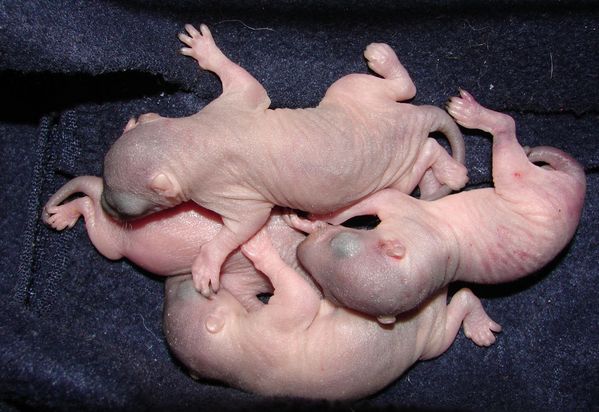
Feb 12, 2007
Baby Squirrels Sarah and Clara
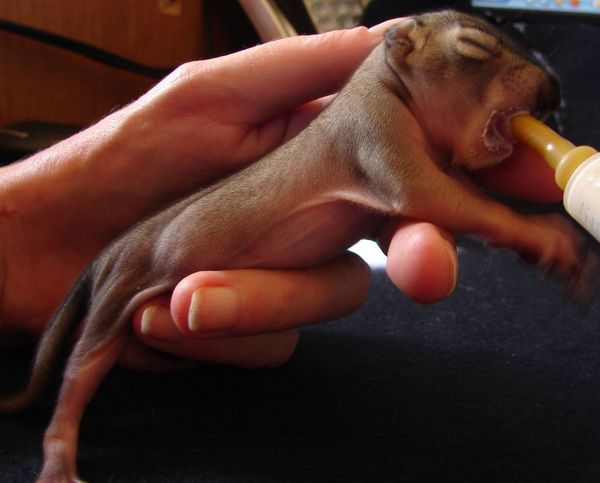
Clara is full now :):
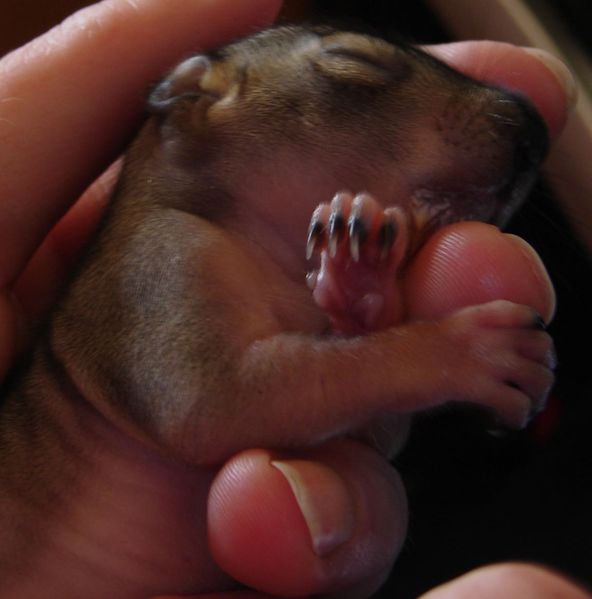
And here is little Sarah, now 5 days old:
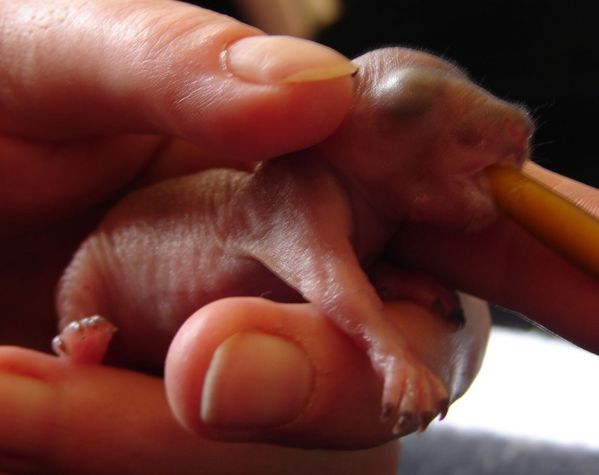
Feb 11, 2007
General Cat Care
Background
Cats were domesticated sometime between 4,000 and 8,000 years ago, in Africa and the Middle East. Small wild cats started hanging out where humans stored their grain. When humans saw cats up close and personal, they began to admire felines for their beauty and grace.
There are many different breeds of cats--from the hairless Sphynx and the fluffy Persian to the silvery spotted Egyptian mau. But the most popular felines of all are non-pedigree—that includes brown tabbies, black-and-orange tortoiseshells, all-black cats with long hair, striped cats with white socks and everything in between.
Cost
When you first get your cat, you’ll need to spend about $25 for a litter box, $10 for a collar, and $30 for a carrier. Food runs about $170 a year, plus $50 annually for toys and treats, $175 annually for litter and an average of $150 for veterinary care every year. The best place to get a cat? Your local shelter! Please visit our shelter directory to find shelters and rescue groups in your area.
Note: Make sure you have all your supplies (see our checklist) before you bring your new pet home.
Basic Care
Feeding
- An adult cat should be fed one large or two or three smaller meals each day.
- Kittens from 6 to 12 weeks must eat four times a day.
- Kittens from three to six months need to be fed three times a day.
You can either feed specific meals, throwing away any leftover canned food after 30 minutes, or keep dry food available at all times. We recommend a high-quality, brand-name kitten or cat food; avoid generic brands. You will need to provide fresh, clean water at all times, and wash and refill water bowls daily.
Although cat owners of old were told to give their pets a saucer of milk, cats do not easily digest cow’s milk, which can cause diarrhea in kittens and cats. Treats are yummy for cats, but don't go overboard. Most packaged treats contain lots of sugar and fat, which can pack on the pounds. Some cats like fresh fruits and vegetables, like broccoli, corn or cantaloupe. You can offer these once in awhile.
If your kitten is refusing food or isn’t eating enough, try soaking her kitten food in warm water. If that doesn’t work, kittens can be fed human baby food for a short time. Use turkey or chicken baby food made for children six months and older. Gradually mix with her regular food.
Grooming
Most cats stay relatively clean and rarely need a bath, but you should brush or comb your cat regularly. Frequent brushing helps keep your cat's coat clean, reduces the amount of shedding and cuts down on the incidence of hairballs.
Handling
To pick up your cat, place one hand behind the front legs and another under the hindquarters. Lift gently. Never pick up a cat by the scruff of the neck or by the front legs.
Housing
Your pet should have her own clean, dry place in your home to sleep and rest. Line your cat's bed with a soft, warm blanket or towel. Be sure to wash the bedding often. Please keep your cat indoors. Cats who are allowed outdoors can contract diseases, get ticks or parasites, become lost or get hit by a car, or get into fights with other free-roaming cats and dogs. Also, cats may prey on native wildlife.
Identification
If allowed outdoors (again, we caution against it!), your cat must wear a safety collar and an ID tag. A safety collar with an elastic panel will allow your cat to break loose if the collar gets caught on something. And if your pet is indoors-only, an ID tag or an implanted microchip can help insure that your cat is returned if he or she becomes lost.
Litter Box
All indoor cats need a litter box, which should be placed in a quiet, accessible location. A bathroom or utility room is a good place for your cat's box. In a multi-level home, one box per floor is recommended. Avoid moving the box unless absolutely necessary. Then do so slowly, a few inches a day.
Keep in mind that cats won't use a messy, smelly litter box, so scoop solid wastes out of the box at least once a day. Dump everything, wash with a mild detergent and refill at least once a week; you can do this less frequently if using clumping litter. Don't use ammonia, deodorants or scents, especially lemon, when cleaning the litter box.
Behavior Information
Play
Cats delight in stalking imaginary prey. The best toys are those that can be made to jump and dance around and look alive. Your cat can safely act out her role as a predator by pouncing on toys instead of people's ankles. Please don't use your hands or fingers as play objects with kittens. This type of rough play may cause biting and scratching behaviors to develop as your kitten matures.
Scratching
Cats need to scratch! When a cat scratches, the old outer nail sheath is pulled off and the sharp, smooth claws underneath are exposed. Cutting your cat’s nails every two to three weeks will keep them relatively blunt and less likely to harm the arms of both humans and furniture.
Provide your cat with a sturdy scratching post, at least three feet high, which will allow her to stretch completely when scratching. The post should also be stable enough that it won't wobble during use, and should be covered with rough material such as sisal, burlap or tree bark. Many cats also like scratching pads. A sprinkle of catnip once or twice a month will keep your cat interested in her post or pad.
Health
Your cat should see the veterinarian at least once a year for an examination and annual shots, and immediately if she is sick or injured.
Ear Mites
These tiny parasites are a common problem that can be transmitted from cat to cat. If your cat is constantly scratching at his ears or shaking his head, he may be infested with ear mites. You will need to call your vet, as your cat's ears will need to be thoroughly cleaned before medication is dispensed.
Feline Urological Syndrome (FUS)
Both males and females can develop this lower urinary inflammation, also called Feline Lower Urinary Tract Disease (FLUTD). Signs of FUS include frequent trips to the litter box, blood in the urine and crying out or straining when urinating. If your male cat looks "constipated," he may have a urethral obstruction and can’t urinate. This can be fatal if not treated quickly. Urethral blockages are rare in females. About five percent of cats are affected with FUS. Special diets may help prevent this condition.
Fleas and Ticks
Flea infestation should be taken seriously. These tiny parasites feed off of your pet, transmit tapeworms and irritate the skin. Carefully check your cat once a week for fleas and ticks. If there are fleas on your cat, there will be fleas in your house. You may need to use flea bombs or premise-control sprays, and be sure to treat all animals in your house. Take care that any sprays, powders or shampoos you use are safe for cats, and that all products are compatible when used together. Cats die every year from improper treatment with flea and tick control products. Please contact your veterinarian for the most effective flea control program for your pet.
Medicines and Poisons
Never give your cat medication that has not been prescribed by a veterinarian. For example, did you know that acetominophin and aspirin can be FATAL to a cat?! Keep rat poison or other rodenticides away from your cat. If you suspect that your animal has ingested a poisonous substance, call your veterinarian or the ASPCA Animal Poison Control Center for 24-hour animal poison information at (888) 426- 4435.
Spaying and Neutering
Female cats should be spayed and male cats neutered by six months of age. Neutering a male (removing the testicles) can prevent urine spraying, decrease the urge to escape outside and look for a mate, and reduce fighting between males. Spaying a female (removing the ovaries and uterus) helps prevent breast cancer, which is usually fatal, and pyometra (uterus infection), a very serious problem in older females that must be treated with surgery and intensive medical care. Since cats can breed up to three times per year, it is vital that your female feline be spayed to prevent her from having unwanted litters.
Vaccinations
* Kittens should be vaccinated with a combination vaccine (called a “3 in 1”) at 2, 3 and 4 months of age, and then annually. This vaccine protects cats from panleukopenia (also called feline distemper), calicivirus and rhinotracheitis. If you have an unvaccinated cat older than four months of age, he will need a series of two vaccinations given 2 to 3 weeks apart, followed by yearly vaccinations.
* There is a vaccine available for feline leukemia virus (FeLV). This is one of the two immune system viruses (retroviruses) that infect cats. The other is feline immunodeficiency virus (FIV). There is no vaccine available for FIV. Cats can be infected with either virus for months, even years, without any indication that they are carrying a fatal virus. All cats should be tested for these viruses.
FeLV and FIV can be transmitted at birth from the mother or through the bite of an infected cat. Neither virus can infect humans. Many outdoor and stray cats and kittens carry this infection. Because of the fatal nature of these diseases, you should not expose cats already living in your home by taking in untested cats or kittens. To be safe, keep your cat indoors—but if your cat does go outside, he should be vaccinated against the feline leukemia virus. Remember, no vaccine is 100-percent effective.
Please note, if your companion cat gets sick because he is not properly vaccinated, the vaccinations should be given after your pet has recovered.
Worms
Kittens and cats can be infected with several types of worms. The key to treatment is correct diagnosis. This will ensure that the medication is effective against the parasite your pet has. A dewormer that eliminates roundworms, for example, will not kill tapeworms. Your veterinarian can best determine the culprit—and prescribe the appropriate medication.
Cat Supply Checklist
- Premium-brand cat food
- Food dish
- Water bowl
- Interactive toys
- Brush
- Comb
- Safety cat collar with ID tag
- Scratching post or scratching pad
- Litter box
- Litter
- Cat carrier
- Cat bed or box with warm blanket or towel
Source: http://www.aspca.org/site/PageServer?pagename=pets_catcare
Feb 10, 2007
Squirrel babies Sarah and Clara Update
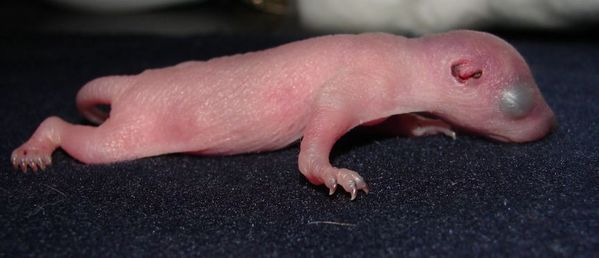
Sarah is 4 days old now.

Clara is about 3.5 weeks old and we are expecting to see her open those pretty little
eyes any day now!
Why does kitty do this?
My cat brings her catch home. I even found a dead mouse on my bed the other day! That's just disgusting. What can I do????Answer:
Cats are predators by nature and are amongst the best hunters in nature. It is their hunting skills, especially their ability to kill mice, that brought cats & people together. Cats were domesticated by farmers thousands of years ago to help them protect their crops from rodents and other animals.
This is augmented by the fact that cats hunt even when they are full. Because kitty views people as either parents or children that need help, he feels compelled to bring us food. In essence kitty is trying to do his "fair share" for the family. This is coupled with kitty's desire to save his 'earnings' makes it more of a problem. Cats have a natural desire to store food for more scarce times.
An example in nature is that of the leopard placing a catch in a tree. To our cats, our homes are those trees and are thus the place where the catch is brought & stored.
Other than keeping kitty an indoor cat, there is little you can do. Continue disposing of the catch as you are doing (please rubber gloves while disposing of the catch and wash thoroughly after handling these animals).
Consider moving the feeding tray to another area so that the kitchen does not become the central depository. Also, be aware that continued exposure to wilds of the outdoors puts your kitty at greater risk of injury and disease.
Feb 9, 2007
Squirrel babies Sarah and Clara

Clara, day 13 at the rescue (3 to 4 weeks old) .

Sarah, 3 days old.
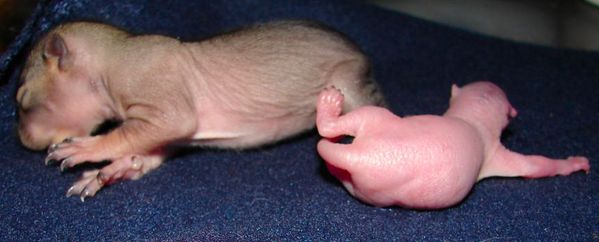
And both of them together to see the 3 weeks difference .
Both are doing fine. Sarah's wounds are crusting over as you can see and she
eats great.
Understanding Your Cat's Body Language
Through body language and demeanor your cat is a skilled communicator. Here's how to read the non-verbal messages your cat is communicating:
On Patrol Of Her Territory
- Perked ears indicate curiosity
- Tail provides balance
- Whiskers measure width
- Sebaceous glands secrete an oily substance with a distinct smell
- Paws planted firmly and confidently on the ground
- Paw pads act as shock absorbers

Ready To Take Action
- Tail acts as a counterbalance as center of gravity shifts forward
- Smooth body fur indicates confidence
- Forward ears show assertiveness
- Dilated pupils indicate excitement
- Concentrated expression
- Hind legs bent, ready for action

Relaxed and Content
- Each whisker is used for sensory perception
- Direct eye contact demonstrates trust
- Tail in relaxed position
- Slanted eyes indicate contentment
- Nose pad receptors
- Ears always attentive

Source: http://www.purina.com/cats/behavior/CatBodyLanguage.aspx
| | |
Feb 8, 2007
Kitten Facts
Look at the ridges on its tiny nose pad. They form a pattern as unique to an individual kitten as a fingerprint is to a human. Behind this nose pad lies a maze of bones and cavities that serve a kitten well. This area, called the mucosa, is nearly twice the size of the olfactory mucosa in humans and indicates the importance of the sense of smell to cats.
A newborn kitten's sense of smell enables it to locate its mother's nipples. Many kittens, shortly after birth, tend to stake out a single nipple which they claim for their own. This acute sense of smell combined with the sense of touch helps guide the newborn until its eyes open at about three weeks and its other senses develop.
The hairless skin of a kitten's nose and its paw pads are particularly sensitive to touch. A kitten learns to use its paws to investigate the texture, size and shape of an unfamiliar object. It may extend a paw, gently touch an object and then touch it firmly before drawing closer to use its nose for a final inspection. Its sense of smell and the tactile paw pads will continue as investigative tools throughout its adulthood.
A newborn kitten relies on its senses of smell and touch because its eyes remain closed for seven to ten days after birth. At first its vision is poor because its retina is not completely developed. It is not able to see as well as an adult for about three months. From then on, its vision becomes one of the most important of its senses.
A kitten's as well as an adult cat's eyes are large compared to the size of its head. If our eyes were as large in comparison to the size of our heads, they would be at least the size of a softball. The large eyes are part of the kitten's heritage, designed to facilitate its work as a hunter.
Throughout its life, a kitten depends upon its whiskers to provide information about its surroundings. Whiskers serve as wind detectors, which, combined with a sense of smell, contribute to its swift identification of the source of any odor. This can be observed as an inquisitive kitten twitches its whiskers as it sniffs.
Whiskers also protect a kitten's and an adult cat's eyes. A springing twig or a sharp blade of grass will touch the whiskers before catching the eye and trigger a protective eye blink. Whiskers fall out periodically to be replaced by new ones.
The loss of whiskers can impair a kitten's or cat's motion and orientation to its surroundings. Sometimes the mother cat will bite off the whiskers of kittens who may wander too far away or are too inquisitive. Mother knows best. Once a kitten is in your custody, never trim or cut off those whiskers.
When a kitten gives you an affectionate lick, you may liken the experience to the feeling of rough sandpaper. This is the result of numerous knobs called papillae on the surface of the kitten's tongue. They form backward-facing hooks which help hold food and provide the abrasion needed for self-grooming.
The taste buds are carried by mushroom-shaped papillae at the tip and sides of the tongue and the cup-shaped papillae at the back of the tongue.
Kittens have their own distinctive eating habits. They tend to consume a large number of small meals. Usually a kitten approaches its food, sniffs it quickly and then starts to eat. After consuming a small portion, a kitten leaves and returns at intervals to eat. This "occasional eating" is typical cat behavior and should not be confused with reluctance or refusal to eat.
As a kitten drinks water, notice how its tongue laps under the water in much the same manner as an elephant uses its trunk. It flicks its tongue quickly in and out of the liquid, swallowing after every third or fourth lap. Because water is involved in virtually every function of a kitten's body, it's important to keep fresh drinking water available at all times in a clean bowl.
While most of us associate catnip with causing a few minutes of extreme playfulness in a kitten, this reaction may not occur. A kitten's capacity to detect and react to catnip is inherited and sometimes described as the presence or absence of a "catnip gene." About 30 percent of cats do not have this gene and will not exhibit any particular behavior in association with catnip. Kittens with the gene usually don't respond to catnip until about six to eight months of age.
A final thought: Perhaps a kitten's most unique trait is its individuality. Each one has its own personality. Properly socializing a new kitten by introducing it with care to its new home, family and friends, will help develop its personality. The result is a delightful companion for years to come.Source: http://gianteagle.petkare.com/index.asp?FrameId=4&CMD=Menu&SId=2236
Another baby squirrel

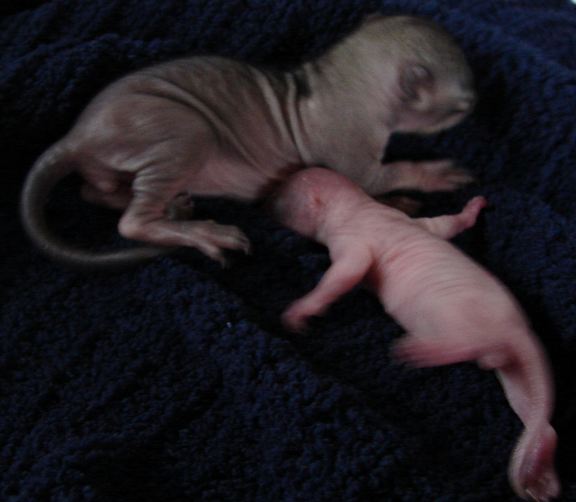
Feb 7, 2007
New Kitten Baby
Always, always isolate a rescued cat or kitten from your pets for at least fourteen days and until it has been examined by your veterinarian and tested for lethal disease; even a tiny kitten can pack a killer virus or parasite.
Make the kitten comfortable in a room that is frequently visited by you and that is separate from your other pets. Wash your hands with an antibacterial soap between visits to the new animal and your household. Consult with your veterinarian so that you are able to weigh the risks against the many blessings of taking in an orphan kitten.
Determine the Kitten's Condition
If the kitten is lethargic or cool to the touch, you may have a life-threatening emergency (such as exposure or distemper). Get the kitten on a heating pad or other primary heat source (see item 2) and get it to a veterinarian right away or consult an emergency veterinary clinic.
Do NOT feed a chilled newborn -- you will kill it. Instead, administer slightly warmed Pedialyte (an infant rehydrating fluid, available in any grocery or pharmacy), using an animal nurser, syringe, or dropper. (You can greatly extend the life of the Pedialyte by freezing it as ice cubes, bagging the cubes and storing them in your freezer, by the way.) Feed the kitten only when it is warmed and indicates it is hungry.
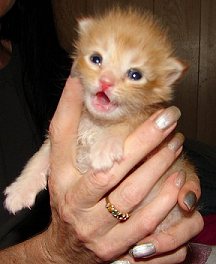
If the kitten seems over-warm and/or is breathing rapidly, it may be feverish or suffering from heat exhaustion or worse. Contact your vet or an emergency veterinary clinic immediately for advice if you can. To help lower the kitten's body temperature, try wiping it down with a cool, damp cloth; then administer Pedialyte. Get the kitten to a veterinarian as soon as possible.
A newborn kitten is not capable of generating or maintaining body warmth and must depend on its mother (and now you) to sustain warmth and life. Keeping a newborn orphan warm (even on a warm day) is a priority, more important initially than feeding (do NOT feed a chilled kitten, by the way -- you will kill it).
Bundling up the kitten will do no good; it has no body heat of its own to retain. And putting the kitten near a space heater or other heating element is neither sufficient for the long-term nor safe.

Wrap a heating pad, set on low, in a towel or flannel and place it in or beneath the nesting box, leaving room for the kitten to crawl off the heated area as needed.
Emergency, short-term measures: If you don't have a heating pad, put the kitten on a wrapped hot water bottle or snuggled against a tightly sealed and well stabilized jar of warm water. Better yet, put the kitten next to your body -- next to the skin if possible.
Then go out and borrow or buy that heating pad after the first feeding or take the kitten to the vet immediately if its condition is poor or questionable.
Newborns cannot evacuate their bowel or bladder unassisted. The kitten you have found may be in excruciating pain or in danger of going toxic from having to retain its own body waste. You should help the kitten empty its bladder before proceeding with warming or feeding or even the trip to the veterinarian.
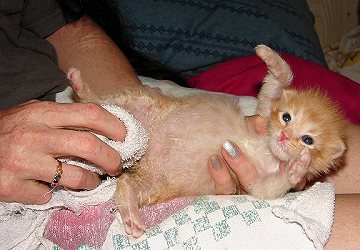
With the kitten on a towel in your lap, lightly rub the kitten's body with a rough, dry washcloth. (At that point, the kitten may roll over or otherwise present its bottom to you.) With a generous handful of soft tissue (a good idea to have handy at all times) gently stroke the kitten's behind, keeping the tissue in contact. The kitten should oblige by urinating a rather amazing amount. Simply rotate the tissue until kitten stops urinating or the tissue is soaked, whichever comes first.
Another method to stimulate evacuation is to use a tissue or wash cloth moistened with warm water instead of a dry cloth or use a moistened Q-tip(hold the kitten over a sink or a folded towel if you use the latter method).
The Formula (more about Formula and feeding HERE)
Never feed a kitten cow's milk or human baby formula as this causes stomach upset and severe diarrhea. If a kitten is already dehydrated, this could prove fatal. This includes condensed/evaporated canned cow's milk!
There are several good milk replacers on the market, available in liquid or powder form (my personal favorite is called Just Born). The ready-mix liquid is more convenient. Be sure the product is engineered for kittens and that it is fresh (some have a short shelf-life). Milk replacers can be found in any pet supplies store, most veterinary clinics, and even in some variety stores.
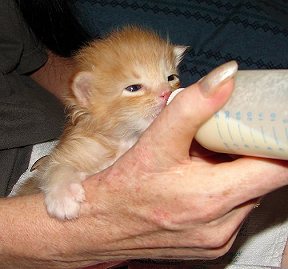
Baby Squirrel Clara 9th day of arrival at the Rainbow Wildlife Rescue
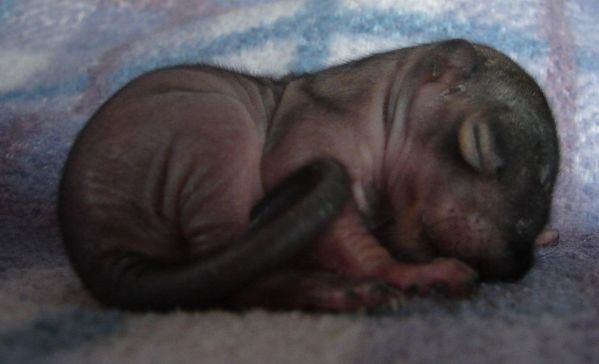
Feb 6, 2007
HOW, WHEN & WHY TO SPAY/NEUTER YOUR CAT
Because of the pet overpopulation problem, more people are spaying/neutering their felines now than ever before. Over 10 million dogs and cats in the United States alone are being put to death by euthanasia each year in animal shelters because there are no homes for them. And, the great majority of these animals are perfectly healthy, friendly and young. Because of this, great care should be taken to prevent pets from unplanned breeding, or breeding without homes available and waiting for the babies. The best solution to this problem is to spay your female pets and neuter your male pets.
There are additional benefits to the pet owner for having this procedure performed on their pets: these benefits include the pet having, for the most part, a longer and healthier life; improved behavior and more responsiveness to their human family; increased safety as spayed and neutered pets are less likely to want to roam the streets outside and become injured or lost in search of a mate; no unwanted kittens; less tendency of the spayed or neutered pet to "mark" or damage household furnishings, and a marked decrease in many medical problems such as mammary cancers and uterine infections which are fairly common in unaltered cats.
Simply put, spaying or neutering removes an animal's ability to reproduce. Spaying of females involves removing the female's uterus and ovaries surgically. Neutering involves the surgical removal of the male's testicles. Both surgeries are performed under general anesthesia, and are considered relatively safe, routine and painless. Usually, the animal is up and about within a day of their operation.
BENEFITS OF SPAYING/NEUTERING YOUR FELINE
There are many benefits to having your pet spayed or neutered. For females, having them spayed will prevent them from going through any more heat cycles. Un-spayed females normally come into heat several times a year, and these cycles can last from several days to several weeks, and include such behaviors as spraying of urine (yes, females can spray, too!!), marking with urine, howling, and some other obnoxious behaviors. Neutering a male before he reaches puberty almost always prevents completely the development of all mating behavior, which includes spraying urine and marking territory with urine, and the desire to roam outside searching for a mate. This in itself puts the cat at great risk for injury or even death from being hit by cars; being the object of human cruelty; infection and disease from other cats; death from natural predators, and cat fighting.
THE SPAY OPERATION (FEMALES)
Most frequently, it is recommended that female kittens be spayed at six months of age, or preferably before their first heat. The surgery, called "ovariohysterectomy", involves anesthetizing the animal, and the veterinarian makes an incision through which the cat's ovaries and uterus are removed. The surgical incision is then closed by either non-absorbable stitches (which must then be removed in approximately 7 to 10 days); or by sub-cuticular stitches, or by sutures that are placed below the skin and that gradually dissolve on their own in the body. There is another procedure that can be performed on female cats, and that is called a "tubal ligation", which is the surgical procedure which makes the female sterile, but does not prevent her from coming into heat and attracting males. Obviously, tubal ligation is not very popular for that very reason!!
We are often asked whether or not female cats can still be spayed even if they are in the middle of a heat cycle. While most vets prefer to perform the surgery in cats not currently in heat, most surgeons will still spay a female kitten or cat when in heat. There is often a small additional charge for this, as there is more time and attention needed during the surgery due to the increased blood supply to the uterus during a heat cycle. But, spaying a kitten or cat in heat is far better than waiting and perhaps having other serious consequences to the feline occur, such as unwanted pregnancy, disease or illness contracted from other cats she may be seeking to mate with.
THE NEUTER OPERATION (MALES)
Another name for the neuter surgery performed on male cats is "castration".
Male cats are usually neutered between 5 1/2 and 9 months of age, before habits such as spraying urine are started. Neutering involves the removal of the source of sex hormones and sperm cells, which is the testicles. The two incisions are usually so small that stitches or sutures are not even needed. And, normally, the cat is sent home the very same day.
NEUTERING VS. VASECTOMY IN MALES
There is another procedure available for preventing fertility in males, and that is a "vasectomy". While a vasectomy renders a male cat sterile, it does not affect testosterone levels as long as the spermatic artery is kept intact. A vasectomized cat, in other words, can mate, but cannot father kittens. This procedure is rarely used for domestic male cats, because a vasectomized male cat would still have territorial issues, still perhaps be prone to fighting other cats to protect that territory, still wander and try to get outside in search of a mate, and still spray urine that has a very strong odor. Vasectomy is still a valid alternative for population control in feral cat colonies, however.
WHAT AGE IS BEST TO SPAY/NEUTER?
The best time to alter your pet is before the animal reaches puberty. Many experts feel that six months of age is an ideal time to spay or neuter. However, there have been numerous studies done that show that healthy kittens spayed or neutered as young as six weeks of age do quite well. The recovery of such young kittens is very quick, and to date, no negative significant concerns have been found. Spaying and neutering kittens and puppies that are healthy at a very young age is becoming a growing trend that has been endorsed by major humane organizations including the Humane Society of the United States, the American Veterinary Medical Association, the American Humane Association, and the Cat Fanciers' Association.
Some people still feel that a kitten should be larger and stronger before undergoing the general anesthesia required to perform the surgery, and to allow more time for the urinary tract system to develop. Consult with your veterinarian and other veterinary health professionals that you trust to help you determine the right age for your kitten or cat. And, speaking of cats, unless your cat has a health problem, spaying/neutering is considered safe at ANY age!! Most of the time, the owners of mature cats -- as well as the cats themselves -- enjoy all the benefits of the spay/neuter surgeries also!!
MORE REASONS TO SPAY/NEUTER
Many families think they would like their children to experience the miracle of birth by having their beloved female kitty have "just one litter". However, when millions of families do this, we see the number of cats euthanized due to pet overpopulation continue to increase. Your library and public television are great sources for this sort of education, and also, locate reputable breeders in your area, and see if they will allow your children to visit when there are young kittens. Be sure to follow any instructions you are given by the breeders as to washing your hands, taking off your shoes, etc. Great care must be taken to protect the health of small kittens and the valuable animals in a breeding program. Professional breeding of purebred animals is a very expensive science involving a great commitment of time, effort, emotion and money. While many people may think that breeding animals would make a great second income...the reality is that little money, if any, can truly be made when the mother cat is properly cared for pre-pregnancy, during breeding and pregnancy, and post-pregnancy, and the kittens are all kept healthy, well fed, wormed, vaccinated, advertised and sold (this is assuming you are lucky enough to have healthy kittens in the first place, and a mother cat willing and able to care for them). The home must be thoroughly kitten-proofed, and even then, there are always going to be some "accidents" on the rugs and furnishings while the kittens are young and learning.
NEW TECHNOLOGIES
There is a spay procedure that is currently widely used in Europe but rarely utilized in the United States. This economically feasible surgical technique is called the "left lateral flank spay", and involves making a small incision through the lateral abdominal wall of the cat. Basically, this technique involves going through the side of the animal as opposed to the animal's stomach area. The animal is shaved on the left flank area, and veterinarians in England and France have found that this procedure is more cost effective, time efficient, and safe for the cats. Originally, this technique was developed for use on feral cats, who were going to be released into the wild within 48 hours of having the surgery.
Source: http://www.hdw-inc.com/spayneuter.htm
Feb 5, 2007
Baby Squirrel Clara's 7th day at the Rainbow Wildlife Rescue
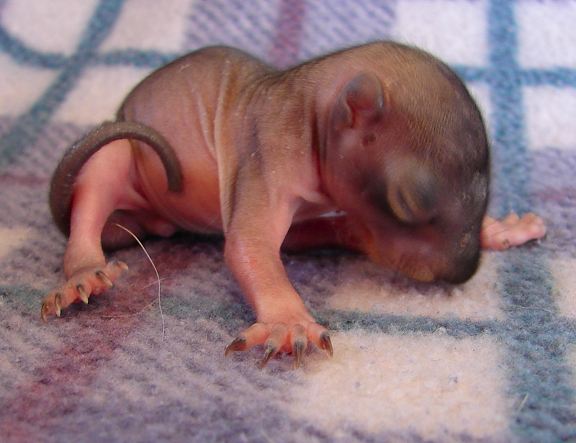
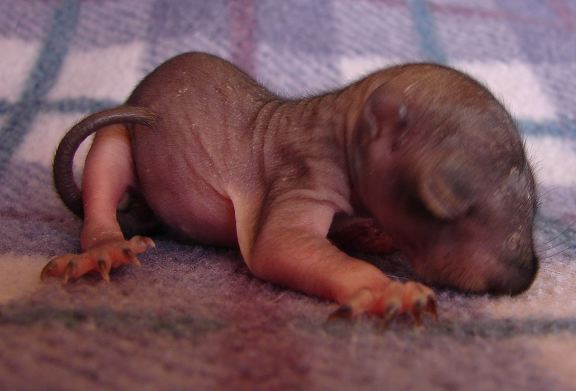
Baby Squirrel Clara's 7th day at the Rainbow Wildlife Rescue
Feb 4, 2007
Squirrel Clara's 6th day at the Rainbow Wildlife Rescue
should, the fur is coming in now and her digestion is picture book perfect. I could not ask for more!!
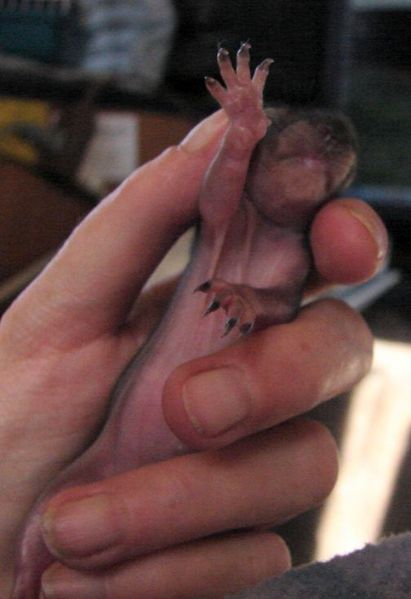
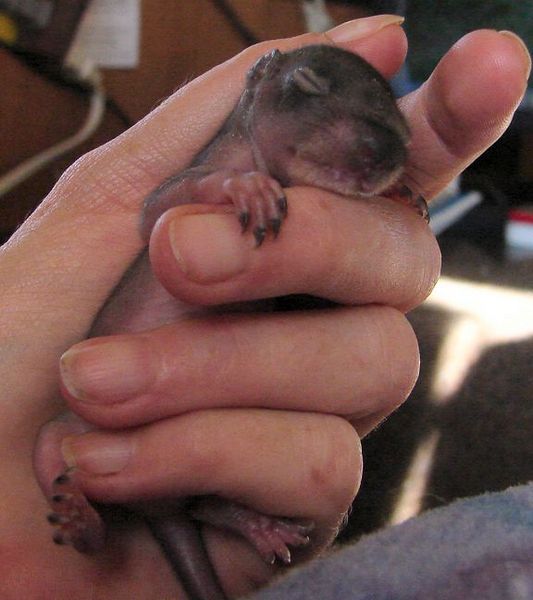
Feb 2, 2007
Kittens and Cats
Litter-box Training your Kitten
Cats don’t need to be trained to use a litter box - they just do it.
By understanding why they prefer to eliminate in a litter box will help their human owners not to make any mistakes in having and maintaining the “cat box”. It is a cat’s basic instinct (even big cats) to eliminate away from their food and sleeping area and to bury the waste in order to hide their position from other animals and protect their nests and young.
Most kittens start using the litter-box at the age of 3-4 weeks on their own. At this young age you can show the kitten where to go and it might happen a bit faster:
Immediately after feeding your kitten, pick her up and gently place her in the litterbox. Scratch the litter a little with your fingers so she can get the idea. If she goes, praise her profusely. If she doesn’t, watch her closely for indications of wanting to go elsewhere. The instant you see her squatting, pick her up and gently place her in the litter-box.
Never throw her in or scold her–it will only associate the box with unpleasant memories in her mind. Every time she uses the box, praise her profusely. You want her to associate her box usage with pleasure.
Keep the box immaculately clean, by scooping it several times a day and changing the litter and washing and disinfecting the box at least twice weekly.
Here are a few things to consider about the litter box:
- Don’t place a litter box close to food or water.
- Some cats do not like covered litter boxes. Not only does the odor tend to stay within the box if it is not kept scrupulously clean but large cats are often not able to achieve a comfortable position for elimination.
- Being meticulous creatures, cats are reluctant to stand on/in half wet or soaking wet litter. If you are unable to clean the box often enough consider getting another box.
- The litter box should only have about a half inch of inch of litter and it should be changed frequently. Cats and especially kittens do not like sinking into a soggy mound of smelly litter. Putting a small amount of litter into the pan saves litter and also means it is easier for you to change.
- Don’t line the bottom of the litter pan with newspaper or use plastic liners. Newspaper smells and those plastic liners form wrinkles for urine and feces to hide. The plastic liners also tear easily.
- If your cat soils a hard surface, it might be a sign that he prefers that type of surface. You might try putting litter on only half the bottom of the litter pan. You should never change brands of litter once you find one that is well liked.
- Clumping litter should be avoided especially with kittens. This type of litter creates more dust, which settles on the kitten, is ingested when the kitten washes itself and then clump inside the kitten’s stomach.
- Longhaired cats and declawed cats are especially sensitive to unclean, deep and smelly litter. A declawed cat’ paws are more sensitive to litter in general. Please read our stand on declawing.
- Do not use harsh or odiferous sprays around the litter box. Cats frequently shy away from chemicals designed to mask odors. Masking bad odors with pleasant ones may be pleasant to you but not to your cat.
- Lack of privacy can also cause problems. Interruption by children and sometimes other pets, such as a dog and loud household noises must be avoided. A quiet location for the litter box is a necessity.
- Urinating outside the litter box is frequently the first sign of a bladder or kidney problem and if the problem persists the cat should be checked out by your veterinarian.
Is the Kitty Dehydrated?
 Hydration is basically how much water we have in our system. Since water drives all of our metabolic functions, you can see why adequate hydration is essential.
Hydration is basically how much water we have in our system. Since water drives all of our metabolic functions, you can see why adequate hydration is essential.
The easiest way to check how hydrated your kitten is, is to grasp the skin firmly but gently between the kitten’s shoulder blades, and lift it straight up with a twisting motion as you release it. If the kitten’s skin is well hydrated it will pop back within a second or less.
The longer it takes the skin to return to its place, the more fluids your kitten needs.
Treatment: A kitten that is noticeably dehydrated should receive prompt veterinary attention. Treatment is directed at replacing fluids and preventing further losses. In mild cases without vomiting, fluids can be given by mouth. If the kitten won’t drink, give an electrolyte solution by bottle or syringe into the cheek pouch.
Balanced electrolyte solutions for treating dehydration in children are available at drugstores. They are given at the rate of two to four milliliters per pound body weight per hour, depending on the severity of the dehydration.
Feed the solution every hour until the skin snaps back accordingly. Then start with a thin milk replacer mixed with the electrolyte solution. Never give a kitten or any other mammal cow’s milk!
Adopting a Kitten
 Whether you adopt a pet from a local animal shelter or a rescue organization, humane society, you’re saving lives.
Whether you adopt a pet from a local animal shelter or a rescue organization, humane society, you’re saving lives.
That’s right: lives, as in more than one. You probably want to adopt just one kitten or cat, right? Adoption saves more than just the life of the pet you adopt.
If you adopt from an animal shelter, you’re making room for another dog or cat, or you’re allowing other dogs or cats at the shelter to be kept for a longer period of time, giving them a better shot at being adopted.

